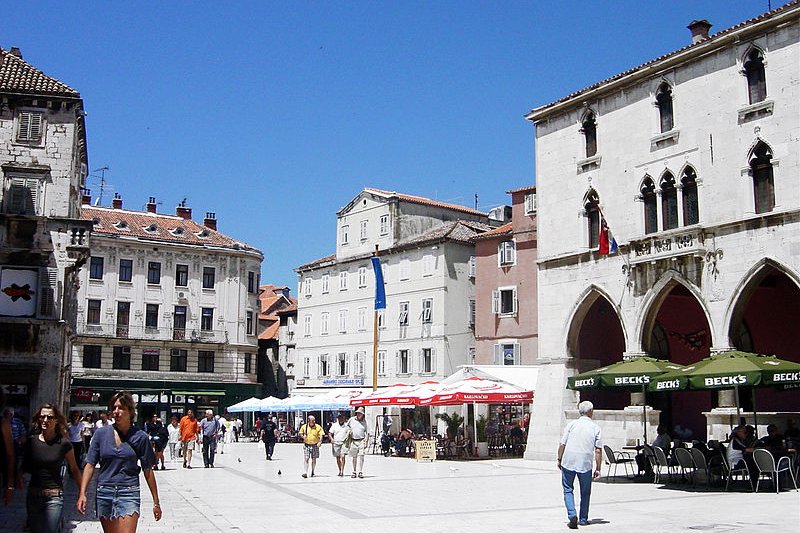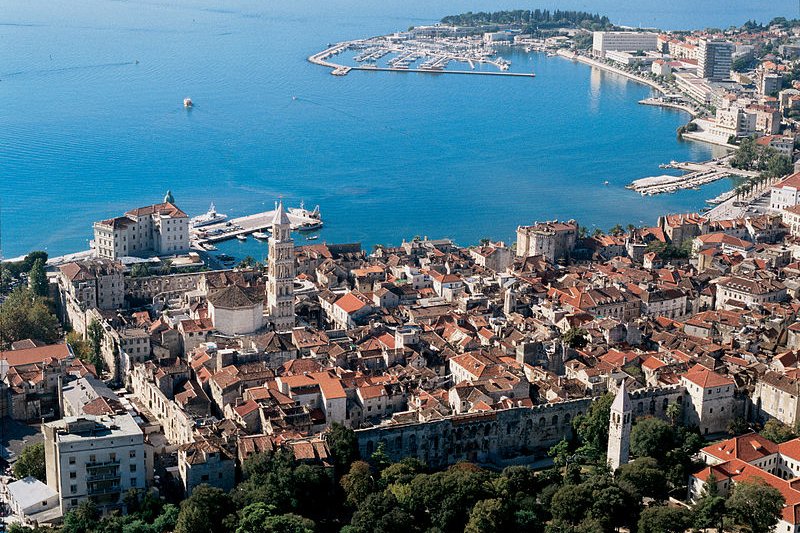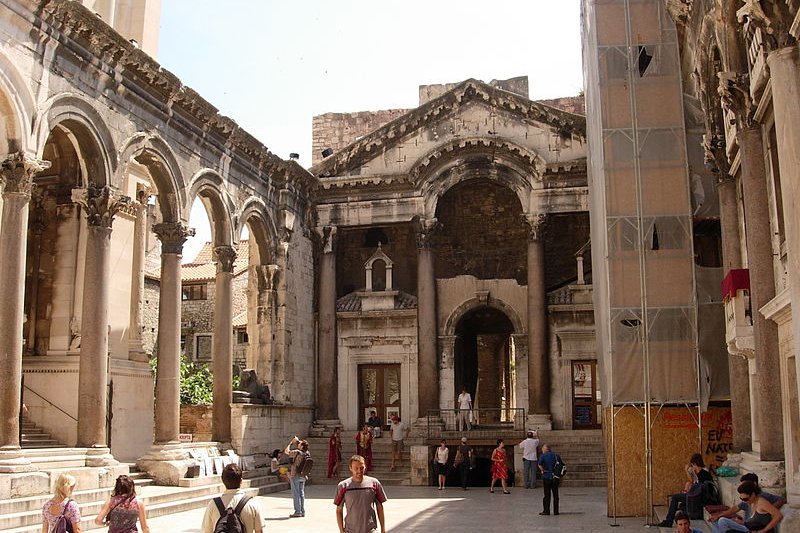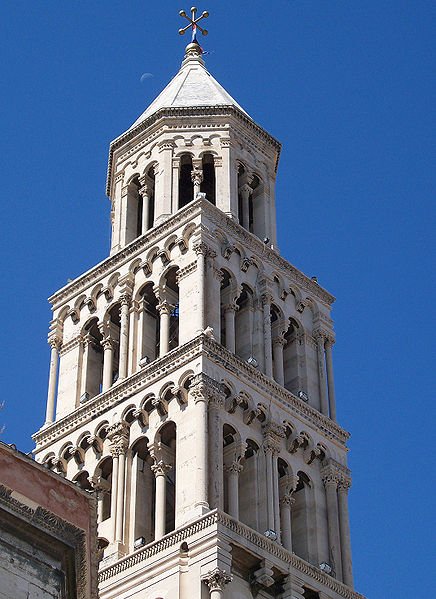 Split, Croatia, at dusk
Split, Croatia, at duskSource: https://commons.wikimedia.org/wiki/File:Croatia_-_Split_-_Riva_under_night.JPG
Author: Michael Angelkovich

Split is the biggest city on the Dalmatian coast, and the second largest in Croatia. It covers 79.38 sq km (30.6 sq mi) and has a population of 178,000 (2011 estimate) within a metropolitan area of 400,000 people.
Split occupies a peninsula that juts out into the Adriatic Sea, between the Gulf of Kaštela and the Split Channel. The city enjoys a Mediterranean climate, with hot, dry summers and mild, wet winters. Hottest month is July, with the average high temperature rises to 29.8°C (86.5°F). Coldest month is January, when the average low temperature drops to 5.4°C (41.7°F). November is the wettest month, receiving 112.9 mm (4.445 in) of precipitation.
 Main Square, Split
Main Square, SplitSource: https://commons.wikimedia.org/wiki/File:Narodni_Trg_%28Pjaca%29.JPG
Author: Epiq

Split is one of the oldest city along the Adriatic coast. The modern city is already some 1,700 years old, while the area itself has been settled as far back as the 6th century BC. The earliest known settlement in Split was a Greek colony called Aspálathos. The surrounding area was inhabited by Illyrian tribes, whose major city was nearby Salona.
By the 3rd century BC, the Romans were becoming increasingly powerful. They conquered the Illyrians between 229 BC and 219 BC, after which they established the province of Dalmatia. The Illyrian city of Salona became the provincial capital, while Aspálathos was annexed and renamed Spalatum.
 Diocletian's Palace, Split
Diocletian's Palace, SplitSource: https://commons.wikimedia.org/wiki/File:Split_iz_zraka.jpg
Author: E.coli

The Roman Emperor Diocletian put Split on the map when he decided to retire from politics and make the city his retirement home. In preparation for his retirement, he began building a huge palace in Split in AD 293. The palace has walls measuring 170 meters by 200 meters, and between 15 to 20 meters high, enclosing an area of 38,000 sq m (9 ½ acres). This "enclosed city" supported a population of between 8,000 to 10,000 people. The palace was completed in AD 305, right on schedule for Diocletian, who became the first Roman Emperor to voluntarily stand down from office. Diocletian's Palace is today a major part of Split. It was recognized as a World Heritage Site in 1979.
AD 476 saw the collapse of the Western Roman Empire, and Spalatum became part of the Byzantine Empire. It continued to be overshadowed by the nearby city of Salona until AD 639, when Salona was brought down by Avar and Slav raiders, and was entirely destroyed. Diocletian's Palace became a place of refuge offering protection with its massive fortifications.
 Wall of Diocletian's Palace complex, Split
Wall of Diocletian's Palace complex, SplitSource: https://commons.wikimedia.org/wiki/File:Split_IMG_8122.jpg
Author: Herwig Storch

By the Middle Ages, the power of the Byzantine Empire was declining, just as neighbouring powers began to rise, among them the Venetian Republic, the Kingdom of Croatia and the Kingdom of Hungary. Split was eventually integrated into the Kingdom of Croatia in 1069. In 1102, the Kingdom of Croatia entered a personal union with the Kingdom of Hungary. Meanwhile, the Venetian Republic was also growing powerful. It managed to gain control of Split whenever there was a moment of weakness in the kingdoms of Croatia or Hungary.
Split finally came under the rule of the Venetian Republic when Hungary sold off Dalmatia in 1420, for just 100,000 ducats. The Venetian Republic held on to Split for 377 years, until its own demise. The city briefly came under Napoleonic rule from 1806 to 1813, before it passed to the Austrian Empire, as the Kingdom of Dalmatia.
 Peristyle, Split
Peristyle, SplitSource: https://commons.wikimedia.org/wiki/File:Split_by_Martin_-_13.JPG
Author: Martin

The First World War brought an end to the Austria-Hungarian Empire. Dalmatia, along with Split, became part of the Kingdom of Serbs, Croats and Slovenes, and later Yugoslavia. During the Second World War, it was occupied first by Italy and later by the Nazis. After the war, it became part of the Socialist Republic of Croatia, which itself is a component of the Socialist Federal Republic of Yugoslavia. In 1992, as Yugoslavia disintegrated, Split became part of the Republic of Croatia.
Visiting Split
The Split Airport (SPU) is the second busiest airport in Croatia. It receives flights from major cities in Croatia as well as from London Heathrow, London Gatwick, Paris Charles de Gaulle, Amsterdam, Belgrade, Vienna, Zürich, among others.Sights & Attractions in and around Diocletian's Palace in Split
- Baptistry of St John (Sv. Ivan Krstitelj)
A small building from the 6th century, originally the Temple of Jupiter, was converted to a baptistry. - Braće Radića Square (Trg Bracć Radića)
Medieval square to the southwest of Diocletian's Palace. - Brass Gate (Mjedena Vrata)
Gate to Diocletian's Palace facing the sea, today facing a seaside promenade. - Cathedral of St Domnius (Katedrala Sv. Duje)
7th century cathedral built over the site of Diocletian's mausoleum, after his sarcophagus was removed, and replaced with the remains of St Domnius.
 Belfry of the Cathedral of Split
Belfry of the Cathedral of Split
Source: https://commons.wikimedia.org/wiki/File:Cathedral_of_Split2.jpg
Author: Beyond silence
- Church of St Dominic (Sv. Dominik)
Church built in the Middle Ages as the Oratory of St Cathedrine, and rebuilt in the 17th century as the Church of St Dominic. - Golden Gate (Zlatna Vrata)
The main entrance to Diocletian's Palace. - Iron Gate (Željezna Vrata)
Western gate to Diocletian's Palace. It has the city's oldest bell, dating to 1081. - Milesi Palace
17th century palace built in the Baroque style. - Museum of Split (Muzej Grada Split)
Housed in the Gothic Papalić Palace within the Diocletian's Palace complex, the msueum displays artifacts and artistic works from the 12th to the 18th century. - Palace of Diocletian
The sprawling palace complex built to receive Emperor Diocletian upon his retirement, today a World Heritage Site. - People's Square (Narodni Trg)
Public square surrounding by historical buildings, among them the 15th century Town Hall, to the west of Diocletian's Palace. - Peristyle
An interior courtyard within Diocletian's Palace. - Silver Gate (Srebrna Vrata)
Gate on the eastern wall of Diocletian's Palace complex, leading towards a market.
Sights & Attractions around Split
- Archaeological Museum (Arheološki Muzej)
Founded in 1820, the archaeological museum has occupied its present site since 1914, making it one of the oldest museums in the country. It displays artifacts from different eras including the Roman, early Christian. - Church of Our Lady of Grace in Poljud (Gospa old Poljuda)
Poljud refers to a neighborhood that was once marshland. The Franciscans built a fortified monastery here in the 15th century. It holds many works of art including Portrait of Bishop Tommaso Nigris by Lorenzo Lotto (1527). - Church of St Francis (Sv. Frane)
Church, recently rebuilt, with a Romanesque-Gothic cloister and a 15th century crucifix. - Marjan Peninsula
Today a nature reserve to the west of Split. The route there passes the 13th century Church of St Nicholas (Sv. Nikola). - Meštrovič Gallery (Galerija Meštrovič)
Gallery housed in a former residence of the famous sculptor, today showcasing some of his works. Entrance fee to this gallery also includes visiting Kaštelet, another residence belonging to Meštrovič. - Museum of Croatian Archaeological Monuments (Muzej Hrvatskih Arheoloških Spomenika)
Museum exhibiting artifacts connected with the history of the area around Split from the early Middle Ages. - National Art Gallery (Galerija Umjetnina)
Gallery exhibiting a vast collection of art work from Split and the Dalmatian region from the 16th to the 20th centuries. - Seven Castles (Kaštela)
A series of fortifications built from the end of the 15th century to the 16th century, by the Venetian Republic when it ruled Split. They were intended to defend the town from raids by the Ottoman Empire. Five of these castles are still standing:
- Abbess Castle (Kaštel Gomilica)
Castle originally located on an island that is now linked to the mainland. - New Castle (Kaštel Novi)
New only by name, this crumbled castle has only its tower and a church standing. - Old Castle (Kaštel Stari)
One of the fortifications that has maintained its original aspect. - St George's Castle (Kaštel Sućurac)
Built at the end of the 14th century, it was the summer residence of the bishop of Split. - Vitturi Castle (Kaštel Lukšić)
Castle that has since been turned into a villa.
 Latest updates on Penang Travel Tips
Latest updates on Penang Travel Tips Discover with Timothy YouTube Channel
Discover with Timothy YouTube Channel PG Food Channel
PG Food Channel Learn Penang Hokkien YouTube Channel
Learn Penang Hokkien YouTube Channel SojiMart Videos
SojiMart VideosLatest from Discover with Timothy: Gurney Bay - what to see and do there
About this website

Hello and thanks for reading this page. My name is Timothy and my hobby is in describing places so that I can share the information with the general public. My website has become the go to site for a lot of people including students, teachers, journalists, etc. whenever they seek information on places, particularly those in Malaysia and Singapore. I have been doing this since 5 January 2003, for over twenty years already. You can read about me at Discover Timothy. By now I have compiled information on thousands of places, mostly in Peninsular Malaysia and Singapore, and I continue to add more almost every day. My goal is to describe every street in every town in Malaysia and Singapore.Robbie's Roadmap
- Episode 1: Robbie's Journey to Financial Freedom
- Episode 2: Lost in America
- Episode 3: The Value of Money
- Episode 4: The Mentor
- Episode 5: The Thing that Makes Money
- Episode 6: The walk with a Billionaire
- Episode 7: The Financial Freedom Awakening
- Episode 8: Meet Mr Washington
- Episode 9: The Pizzeria Incident
Copyright © 2003-2024 Timothy Tye. All Rights Reserved. - Abbess Castle (Kaštel Gomilica)


 Go Back
Go Back